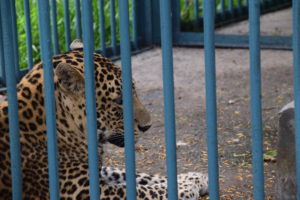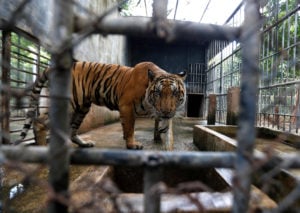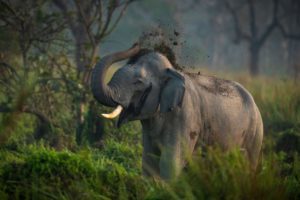The bamboo-and-net pen looks like a small hen’s cage. Inside, however, is a black kite – a large bird of prey. The raptor is a resident of a small ‘zoo’ in the Manakamana Community Forest in eastern Nepal’s Morang district, the last survivor of a set of six kites that had been handed over to the Manakamana community forest users’ group (CFUG) two years ago. With limited regulation, such CFUG-managed ‘zoos’ have proliferated in Nepal, but the state of the animals in them is raising a host of concerns among conservationists.
At the centre of the issue are CFUGs, a legally mandated system of decentralised forest governance that Nepal has pioneered in South Asia since the 1980s. A provincial government’s Division Forest Office is authorised to hand over management of areas declared as community forests to local residents under Nepal’s 1993 Forest Act. This initiative was designed to enrich local communities by allowing them to manage and utilise the natural resources of their area, via sustainable forest management plans approved at the provincial level.
Then Nepal passed the Forests Act, 2076 (2019), which consolidated its forest laws. Clause 34 permitted CFUG activities to include eco-tourism and “wildlife farming”. The legal basis of wildlife conservation in Nepal draws from the National Parks and Wildlife Conservation Act, 2029 (1973), which refers to wildlife parks and reserves, but does not directly address zoos. The rules and regulations around what CFUGs can do are still to be finalised, so existing CFUG-run ‘zoos’ do not fall under a clear regulatory mechanism. Nonetheless, because they are legally allowed to sell tickets for tourists to see animals kept in captivity, such ‘zoos’ have proliferated.
Informal zoos proliferate without safeguards
According to a 2019 research paper by the National Zoological Garden, 17 such ‘zoos’ were running in Nepal at that time. The paper also noted that insufficient attention was being paid to animal care at these facilities, and that skilled personnel, such as veterinarians, or those trained to nurse injured or sick animals, were lacking.
In Manakamana, this is evident.
The current chair of the Manakamana CFUG management committee is Udayakumar Rai, who tells The Third Pole that six kites were originally transferred from the Division Forest Office. Rai says that five birds died from fighting amongst themselves, and a lack of proper care. In addition, two leopard cats died after fighting in a cage, while six peacocks died within a month of being dropped off by local people, who sold them to the CFUG for an undisclosed sum. Two pythons that Rai’s team brought from a wetland within the forest didn’t survive beyond three months. Pythons are protected in Nepal, primarily inhabiting wetlands and swampy areas in Terai, the lowland region that runs along the country’s southern border.
It is unclear if these animals were actually injured or ill and brought to the ‘zoo’ to be taken care of, or if they were merely spotted in the wild and picked up. While Rai says his team rescued them, CFUGs are subject to limited supervision, except when an animal dies. In such an instance, a representative from the forest office visits to conduct an examination and witness burial of the carcass.
These days, the Manakamana ‘zoo’ is home to a family of five deer and a rhesus macaque. The latter is in a cage, surrounded by foul-smelling rubbish. “We used to have langurs and wild cats, but they also died as we lacked proper knowledge to take care of them,” says Rai. While the enclosures are legally meant for the care of injured or sick animals, Rai says the ‘zoo’ was established to attract visitors – they have even constructed a tree house to attract TikTok creators.
Rai says he was inspired to open the ‘zoo’ in Manakamana after learning of another to the east, in Shanti Community Forest. The situation there is no better: Every wild animal that was introduced in 2015 has died, according to Hembhakta Gurung, the vice president of the CFUG in this area. The ‘zoo’ in Shanti Community Forest previously housed pythons, deer, wild cats, leopard cats, nilgai antelope, civets, monitor lizards, Himalayan vultures and more. Gurung blames their deaths on a lack of ‘management initiatives’.
Conservation or profit?
The largest such ‘zoo’ in Koshi province is in the Jamunabari Community Forest in Jhapa, Nepal’s easternmost district. It is home to 29 species of wild animal, including an adult leopard. The forest’s management plan incorporates an animal rescue centre; unusually, its operation is approved by the Division Forest Office.
Nonetheless, when The Third Pole speaks with Tara Koirala, a member of Jamunabari CFUG’s board of directors, she says that they consider tourism to be the primary focus of the zoo, with conservation being of secondary importance. The zoo has 15 empty cages waiting to be filled. “If provided, we can even house tigers and crocodiles. However, we lack [the] technical manpower to take care of these wild animals,” says Koirala. Furthermore, Koirala and the president of the CFUG, Khemraj Sitoula, say they have budgeted NPR 120,000 (approximately USD 900) to buy two ostriches for the zoo. According to documents seen by The Third Pole, Jamunabari made more than NPR 5,000,000 (USD 38,000) from the entry fees they charged between July 2021 and September 2022. This is a large sum for Nepal, where the per-capita GDP in 2022 was USD 1,336.50.
Environmentalists deeply concerned
Dibya Raj Dahal, the chair of an NGO called the Small Mammal Conservation and Wildlife Foundation Nepal (SMCRF) and a zoology teacher in Morang, is worried by this trend. “Wild animals are kept in cages after they are brought from their natural habitat, in the name of rescue. The cages are not good, since there are no facilities [nor] a good environment for [the animals’] survival.”
If we focus solely on tourism, it leads to misuse and that acts as a death trap for wild animalsRachana Shah, head of the Biodiversity Conservation Centre
Rachana Shah, head of the National Trust for Nature Conservation’s Biodiversity Conservation Centre, explains that wild animals require environments they are familiar with in order to survive in captivity, whether “rugged terrain conditions for mountain-dwelling species” or “flat terrain for animals from lowlands”. Shah worked at Nepal’s only government-authorised zoo, the Sadar Chidiyakhana (Central Zoo) in Kathmandu, for more than two decades. She says that enclosures should replicate wild animals’ natural environments, for instance, incorporating burrows for porcupines. Furthermore, Shah says “if we focus solely on tourism, it leads to misuse and that acts as a death trap for wild animals.”
Pushing for regulation
The commercial exploitation of wild animals under the guise of conservation is an issue recognised by key figures in government. “Zoos in community forests prioritise income generation over conservation education and that’s the root of this problem,” says Meghnath Kafle, head of biodiversity at the Ministry of Forests and Environment. Kafle blames the issue on a lack of official processes for the establishment of such ‘zoos’.
The director general of Nepal’s Department of National Parks and Wildlife Conservation (DNPWC), Maheshwar Dhakal, acknowledges the positive role that CFUGs can play in taking care of injured or sick animals, but is also aware of the potential harm of informal zoos being run without any sort of regulation. “No-one has been granted permission to operate such a zoo thus far from the DNPWC,” he clarifies. But while acknowledging that “there is a need to train manpower to fix this problem,” the DNPWC has not put any plans in place to make this happen.
While regulation is a concern for everybody, it is unclear which department or ministry would step in. Rewati Raman Poudel, secretary at the Ministry of Forest and Environment, tells The Third Pole that comprehensive rules and guidelines around such ‘zoos’ are being formulated and will be completed this year: “The guidelines will address the issue of what actions should be taken against [informal] zoos that fail to meet the prescribed standards.” So far, though, nobody knows what those standards are, or who will determine them.











